The sound of the Vikings, with a heavy metal twist
New York Times
last updated: Sep 04,2022

BORRE,
Norway — “We have vegan potato salad in the medium cauldron,” Maria Franz
announced to the 17 members of Heilung, her folk metal band, as they gathered
around a campfire here recently. The band was celebrating the release of its
third album, “Drif,” at Midgardsblot, a festival that takes place on a Viking burial ground and also includes seminars on Viking culture for an audience of
campers, many of whom were dressed up in tunics and cloaks. Earlier that day,
festivalgoers joined the band to listen to the new album while sitting on the
floor of a replica Viking feast hall rigged up with a speaker system.اضافة اعلان
It was the perfect setting for Heilung, whose work over the past eight years has put a heavy metal twist on the music of pre-Christian Europe. Working with a team of researchers and performing on replica instruments from the period, Heilung produces music that its members describe as “amplified history.” Heilung takes its lyrics from historical texts, like runic inscriptions on archaeological finds, and uses sound sources that would have been available to early European civilizations, such as stones, bones, and crude metal objects struck together.
“Drif,” for instance, combines throat singing, spoken word, chanting, battle sounds and field recordings from nature. One of Heilung’s songs, “Hakkerskaldyr,” was used in a trailer for a recent Robert Eggers film, “The Northman,” another artistic imagining of ancient Scandinavia.
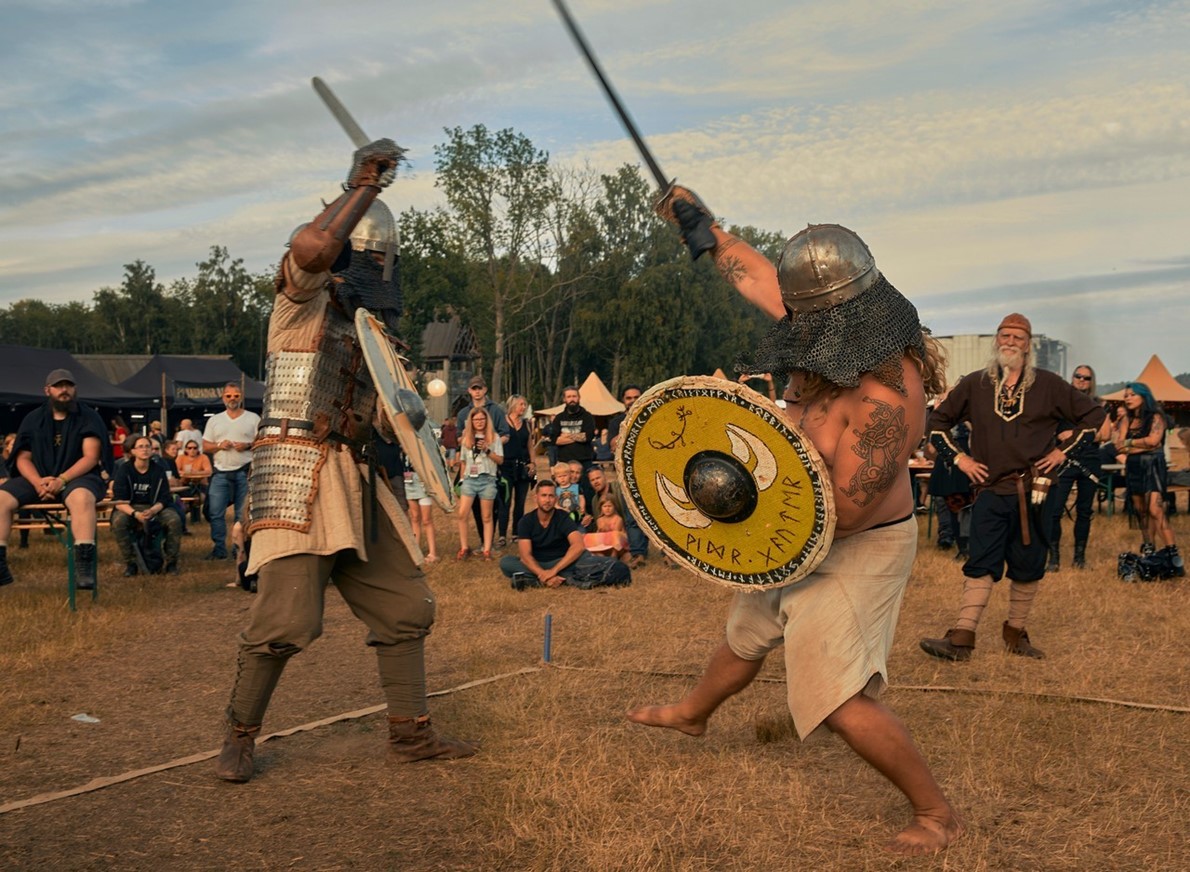
A Viking battle demonstration at the Midgardsblot festival, where the band Heilung played from their new album “Drif,” in Borre, Norway, September 19, 2022.
“We’re not claiming that we are doing the exact same thing as our ancestors did, because no one knows,” Franz said. “But it’s our interpretation of how it might have felt.”
Heilung has three core members — Franz, Christopher Juul, and Kai Uwe Faust — who are supported by a large cast of onstage performers, including actors dressed as Viking warriors, backing singers and drummers.
Franz said the band’s project was about more than just focusing on the Viking era, though. Its members want to tap into what they see as a shared ancient history that goes beyond European borders and encompasses all of humanity. For instance, “Marduk,” the last track on the new album, is a recital of 50 names of the highest god of the Mesopotamians. Franz sometimes plays a primitive instrument she brought back from India: a stick, half a coconut, some goat skin, and strings. If you look back far enough into history, Juul said, you find that most cultures share similar instruments, and similar myths.
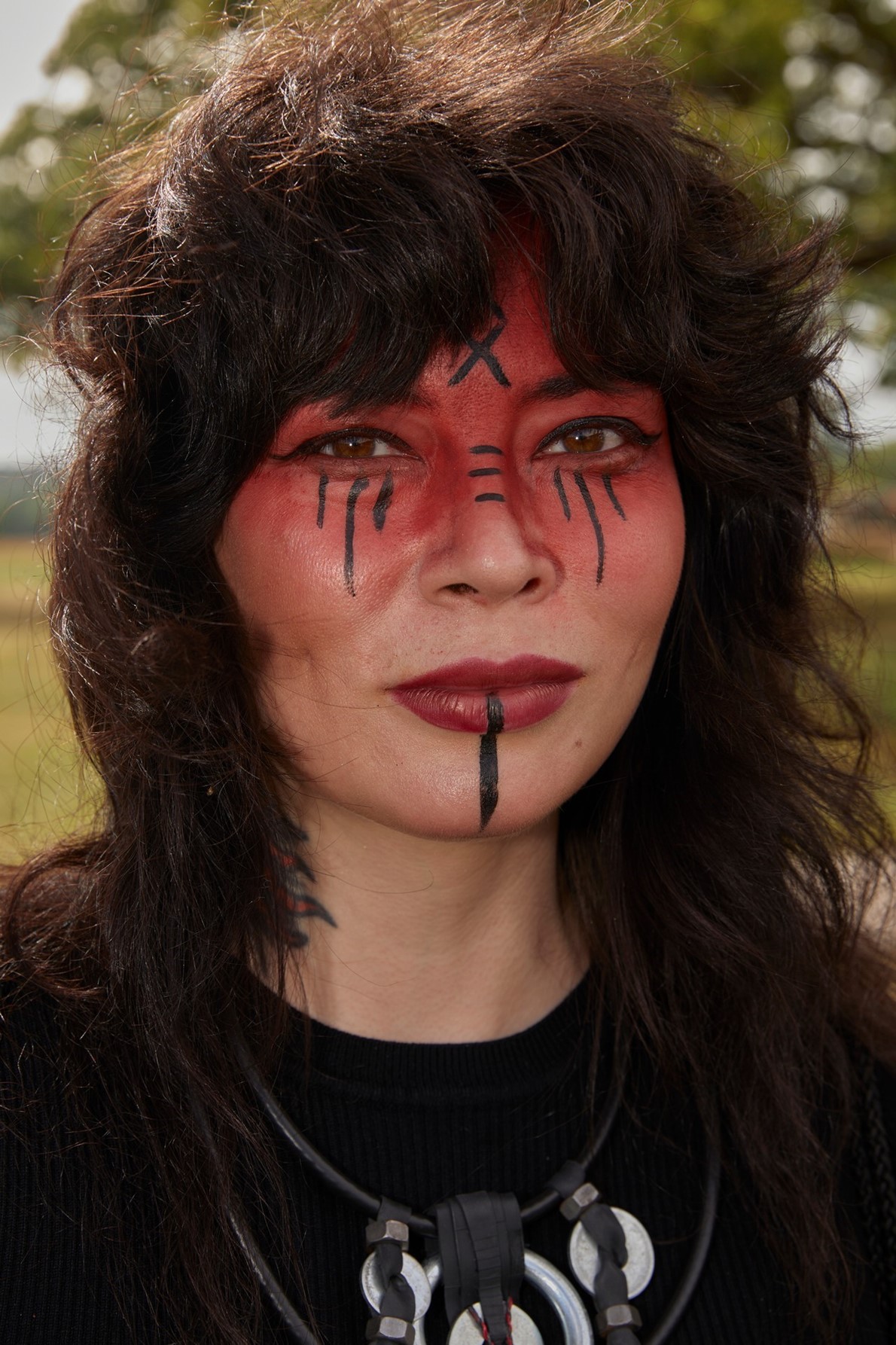
People listen to the band Heilung, which performs with replicas of ancient instruments, play from their new album “Drif,” their third, in a replica Viking feast hall at the Midgardsblot festival in Borre, Norway, September 19, 2022.
There are other bands in the subgenre of folk metal that draw on pre-Christian history, like the Norwegian group Wardruna. But Heilung stands out for the depth of its historical engagement and the scale of its live performances. The band’s self-released debut album, “Ofnir,” was well-received in folk metal circles, but it was not until the band’s first live shows, in 2017, that Heilung became popular in the broader metal scene.
“It was a phenomenon,” said Jonathan Selzer, a music journalist at Metal Hammer magazine. He remembered seeing the band at Midgardsblot, in 2017, when it played the penultimate slot. The set incorporated elaborate costumes, including antlers and animal furs, battle cries and half-naked actors playing warriors charging around the stage. This performance set the blueprint for all of Heilung’s stage shows since. “You could just see this realization going through the crowd in real time, from incomprehension to wonder,” Selzer said. “The whole field turned into Viking rave.”
Michael Berberian, who signed Heilung after that show to Season of Mist, a metal label he runs, said it was “a band that popped out of nowhere with a complete concept.” He added that “the visual aspects, the costume, the unique music, the production values were all there, fully ready.”
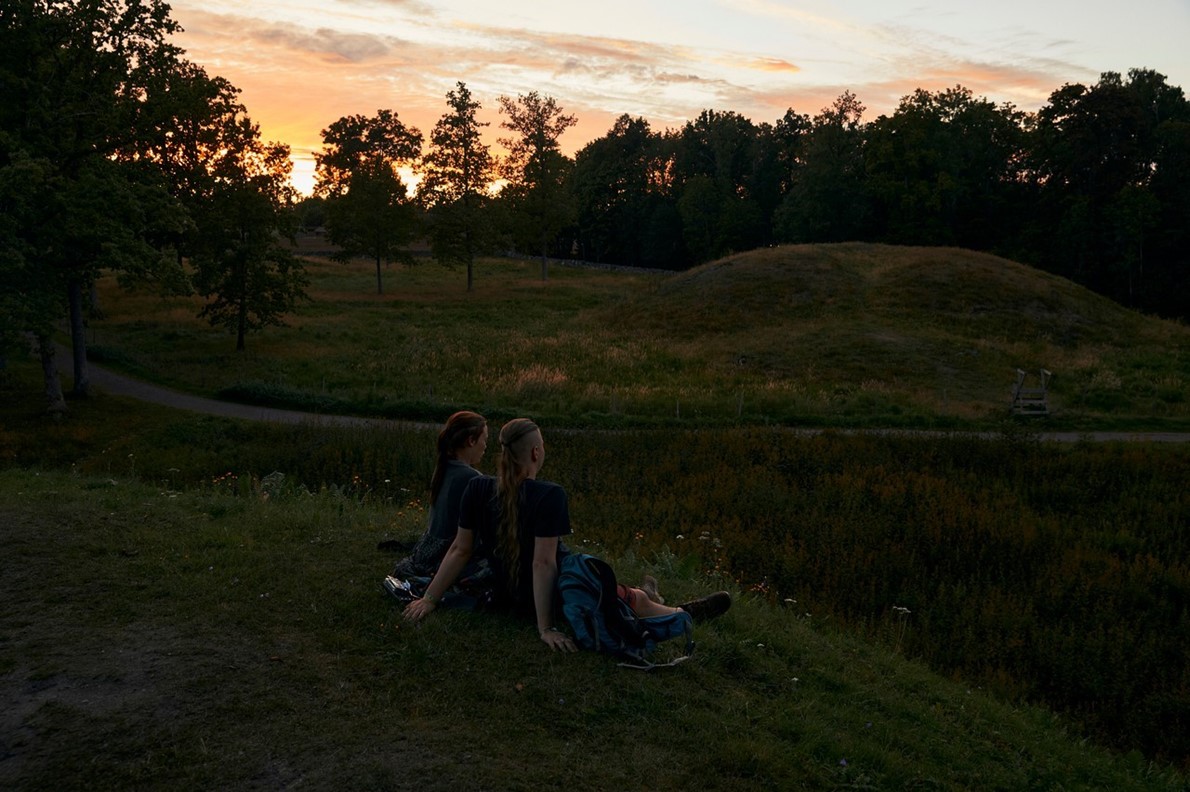
People relax atop a Viking burial mound at the Midgardsblot festival, where the band Heilung played from their new album “Drif,” in Borre, Norway, September 19, 2022.
Franz, Faust, and Juul first met through the Viking reenactment scene, in which enthusiasts gather to dress up as Vikings, learn about their history and practice their traditions, such as sword fighting and cooking over an open fire. Runa Strindin, Midgardsblot’s founder, said the popularity of Viking reenactments had exploded over the past five years in northern Europe, spurred by TV shows like “Vikings” and movies like “The Northman”, as well as the inclusion of Norse gods in the Marvel movies.
“People are searching for an identity to come closer to something that is missing in their modern lives,” Strindin said, “and they are attracted to the Norse mythologies because it’s so easily adaptable. Whatever suits you, you will find it there.”
Norse mythology also resonates with some far-right groups that see it as an endorsement of their ideology, but Heilung’s members strongly reject that worldview. For at least a century in Scandinavia, extreme nationalists have adopted the visual language of ancient runes to suggest an imagined, pre-modern era of racial purity, and neo-Nazis have used the symbols to identify themselves to one another.
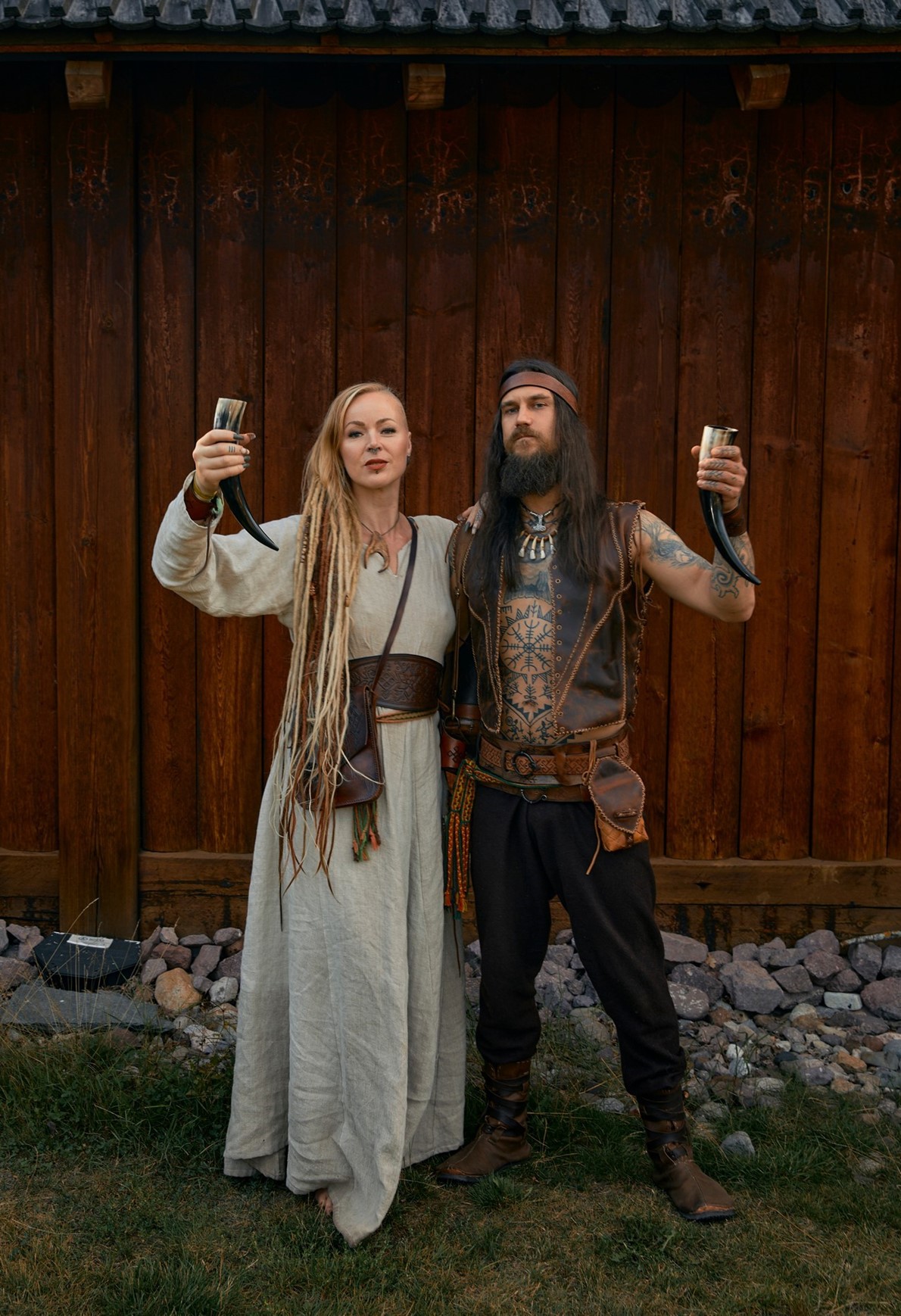
A fan of the band Heilung at the Midgardsblot festival, which takes place on a Viking burial ground and includes seminars on Viking culture, in Borre, Norway, September 19, 2022.
The connection between Nordic runes and white supremacy is still strong. Anders Behring Breivik, a Norwegian extremist, marked the weapons he used in a 2011 massacre with runes, and the perpetrator of the Christchurch, New Zealand, mosque terrorist attack in 2019 emblazoned a sonnenrad — a rune symbol that was appropriated by the Nazis to embody their ideal vision of an Aryan identity — on his backpack.
Selzer, the music journalist, said that, outside the metal scene, many people were wary about bands in the folk metal subgenre, whose merchandise and visual branding features runic symbols or who go to runic inscriptions for lyrics.
Reclaiming Viking culture, particularly the runes, from neo-Nazis was a central part of Heilung’s mission, Strindin said. Each of the band’s live shows opens with a recited poem that emphasizes the audience’s shared humanity. “Remember that we all are brothers, all people, and beasts and trees and stone and wind,” reads one line.
Strindin said that when she was growing up in Norway, in the 1990s, taking an interest in runes was discouraged by teachers and parents, because of their far-right associations. Heilung, she said, was “helping to take those symbols back, and put new meaning to them,” one that emphasized their original, spiritual intentions.
“We see music as a cup,” Faust said. “You can have a beautiful cup, but a cup is supposed to transport something. So I was always more interested in the content: What am I doing with these frequencies? What is my intent, with these songs?”
At the album listening session in the replica Viking hall, there was a quiet, respectful atmosphere, like a church. People closed their eyes to listen, or read through a booklet of explanatory notes the band had provided to accompany each track.
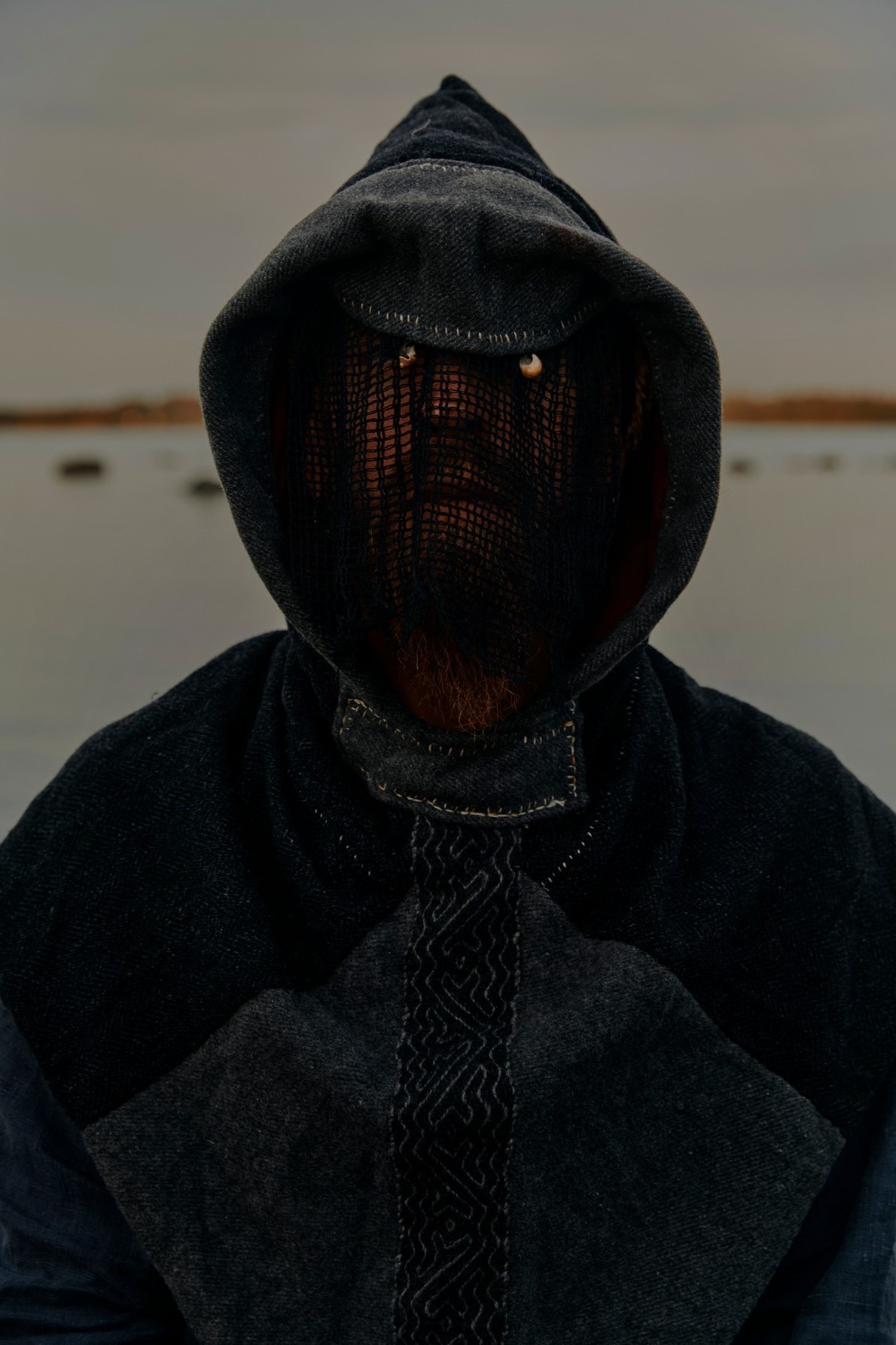
Kai Uwe Faust a member of the band Heilung, at the beach near the Viking burial mounds in Borre, Norway, September 19, 2022.
The next day, Heilung played the festival’s headline slot to a crowd of fans who had come from all over the world. Lindsey Epperson, 32, from Tucson, Arizona, who had left the United States for the first time to be there, said the band’s music was “familiar, even though I wasn’t from that time,” adding, “It sounds like home to me.”
A hush fell over the crowd as the show began. A performer wafted incense out over the audience, and the rest of the band gathered in a circle to recite the opening poem. They left a break after each line, so the crowd could chant it back with one voice.
Read more Music
Jordan News
It was the perfect setting for Heilung, whose work over the past eight years has put a heavy metal twist on the music of pre-Christian Europe. Working with a team of researchers and performing on replica instruments from the period, Heilung produces music that its members describe as “amplified history.” Heilung takes its lyrics from historical texts, like runic inscriptions on archaeological finds, and uses sound sources that would have been available to early European civilizations, such as stones, bones, and crude metal objects struck together.
“Drif,” for instance, combines throat singing, spoken word, chanting, battle sounds and field recordings from nature. One of Heilung’s songs, “Hakkerskaldyr,” was used in a trailer for a recent Robert Eggers film, “The Northman,” another artistic imagining of ancient Scandinavia.

A Viking battle demonstration at the Midgardsblot festival, where the band Heilung played from their new album “Drif,” in Borre, Norway, September 19, 2022.
“We’re not claiming that we are doing the exact same thing as our ancestors did, because no one knows,” Franz said. “But it’s our interpretation of how it might have felt.”
Heilung has three core members — Franz, Christopher Juul, and Kai Uwe Faust — who are supported by a large cast of onstage performers, including actors dressed as Viking warriors, backing singers and drummers.
Franz said the band’s project was about more than just focusing on the Viking era, though. Its members want to tap into what they see as a shared ancient history that goes beyond European borders and encompasses all of humanity. For instance, “Marduk,” the last track on the new album, is a recital of 50 names of the highest god of the Mesopotamians. Franz sometimes plays a primitive instrument she brought back from India: a stick, half a coconut, some goat skin, and strings. If you look back far enough into history, Juul said, you find that most cultures share similar instruments, and similar myths.

People listen to the band Heilung, which performs with replicas of ancient instruments, play from their new album “Drif,” their third, in a replica Viking feast hall at the Midgardsblot festival in Borre, Norway, September 19, 2022.
There are other bands in the subgenre of folk metal that draw on pre-Christian history, like the Norwegian group Wardruna. But Heilung stands out for the depth of its historical engagement and the scale of its live performances. The band’s self-released debut album, “Ofnir,” was well-received in folk metal circles, but it was not until the band’s first live shows, in 2017, that Heilung became popular in the broader metal scene.
“It was a phenomenon,” said Jonathan Selzer, a music journalist at Metal Hammer magazine. He remembered seeing the band at Midgardsblot, in 2017, when it played the penultimate slot. The set incorporated elaborate costumes, including antlers and animal furs, battle cries and half-naked actors playing warriors charging around the stage. This performance set the blueprint for all of Heilung’s stage shows since. “You could just see this realization going through the crowd in real time, from incomprehension to wonder,” Selzer said. “The whole field turned into Viking rave.”
Michael Berberian, who signed Heilung after that show to Season of Mist, a metal label he runs, said it was “a band that popped out of nowhere with a complete concept.” He added that “the visual aspects, the costume, the unique music, the production values were all there, fully ready.”

People relax atop a Viking burial mound at the Midgardsblot festival, where the band Heilung played from their new album “Drif,” in Borre, Norway, September 19, 2022.
Franz, Faust, and Juul first met through the Viking reenactment scene, in which enthusiasts gather to dress up as Vikings, learn about their history and practice their traditions, such as sword fighting and cooking over an open fire. Runa Strindin, Midgardsblot’s founder, said the popularity of Viking reenactments had exploded over the past five years in northern Europe, spurred by TV shows like “Vikings” and movies like “The Northman”, as well as the inclusion of Norse gods in the Marvel movies.
“People are searching for an identity to come closer to something that is missing in their modern lives,” Strindin said, “and they are attracted to the Norse mythologies because it’s so easily adaptable. Whatever suits you, you will find it there.”
Norse mythology also resonates with some far-right groups that see it as an endorsement of their ideology, but Heilung’s members strongly reject that worldview. For at least a century in Scandinavia, extreme nationalists have adopted the visual language of ancient runes to suggest an imagined, pre-modern era of racial purity, and neo-Nazis have used the symbols to identify themselves to one another.

A fan of the band Heilung at the Midgardsblot festival, which takes place on a Viking burial ground and includes seminars on Viking culture, in Borre, Norway, September 19, 2022.
The connection between Nordic runes and white supremacy is still strong. Anders Behring Breivik, a Norwegian extremist, marked the weapons he used in a 2011 massacre with runes, and the perpetrator of the Christchurch, New Zealand, mosque terrorist attack in 2019 emblazoned a sonnenrad — a rune symbol that was appropriated by the Nazis to embody their ideal vision of an Aryan identity — on his backpack.
Selzer, the music journalist, said that, outside the metal scene, many people were wary about bands in the folk metal subgenre, whose merchandise and visual branding features runic symbols or who go to runic inscriptions for lyrics.
Reclaiming Viking culture, particularly the runes, from neo-Nazis was a central part of Heilung’s mission, Strindin said. Each of the band’s live shows opens with a recited poem that emphasizes the audience’s shared humanity. “Remember that we all are brothers, all people, and beasts and trees and stone and wind,” reads one line.
Strindin said that when she was growing up in Norway, in the 1990s, taking an interest in runes was discouraged by teachers and parents, because of their far-right associations. Heilung, she said, was “helping to take those symbols back, and put new meaning to them,” one that emphasized their original, spiritual intentions.
“We see music as a cup,” Faust said. “You can have a beautiful cup, but a cup is supposed to transport something. So I was always more interested in the content: What am I doing with these frequencies? What is my intent, with these songs?”
At the album listening session in the replica Viking hall, there was a quiet, respectful atmosphere, like a church. People closed their eyes to listen, or read through a booklet of explanatory notes the band had provided to accompany each track.

Kai Uwe Faust a member of the band Heilung, at the beach near the Viking burial mounds in Borre, Norway, September 19, 2022.
The next day, Heilung played the festival’s headline slot to a crowd of fans who had come from all over the world. Lindsey Epperson, 32, from Tucson, Arizona, who had left the United States for the first time to be there, said the band’s music was “familiar, even though I wasn’t from that time,” adding, “It sounds like home to me.”
A hush fell over the crowd as the show began. A performer wafted incense out over the audience, and the rest of the band gathered in a circle to recite the opening poem. They left a break after each line, so the crowd could chant it back with one voice.
Read more Music
Jordan News

